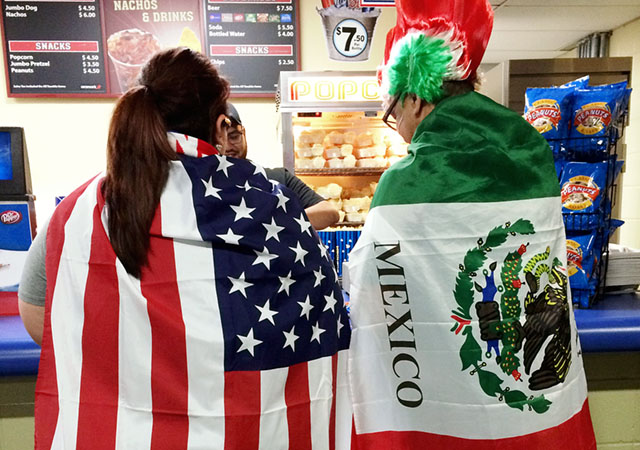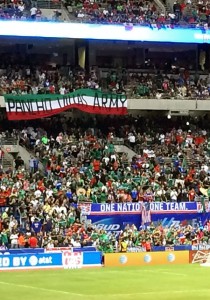Conflicted Allegiances at Mexico-U.S. Soccer Match

Patricia Erebia and her father, Juan, attended the soccer friendly in April at the Alamodome in San Antonio, where some American fans of Mexican descent had to choose sides: the country of their citizenship or the country of their ancestors? Photo by M. Mikayla Martinez
By M. Mikayla Martinez
For Reporting Texas
A Selena ballad and smoke from grilling turkey legs filled the air around the Alamodome, already thick with anticipation.
Among the painted faces, luchador masks and flag capes, a two-legged taco pushed its way into one of the lines forming on the April afternoon of the sold-out soccer friendly between the United States and Mexico.
“You can’t tell if I’m an American citizen or a Mexican citizen,” said San Antonio native Eric Gomez, the man inside the costume. “I’m just a taco. Everyone loves tacos.”
The distinctly hybrid culture of San Antonio, a blend of American and Mexican traditions and influences, created a sort of conflict for many Mexican-American fans. For this game, wearing a jersey — or a taco — meant choosing the country with which to side while identifying with both. It gets more complicated for Mexican-American fans the longer they’ve been in the U.S., noted 21-year-old University of Texas at Austin economics student Julio Fascowich.
“When you’re born in the U.S., but you have family in Mexico, that’s when you have a dilemma,” Fascowich said. “Is it Mexico, your roots, or the place you live?”
Where, how and with whom you grow up, as well as the different levels of popularity soccer enjoys in the two countries, play large parts in the decision process, said Dr. Tolga Ozyurtcu, clinical assistant professor of sports management at the University of Texas at Austin.
“It doesn’t matter if you’re of Mexican descent, born in San Antonio and don’t speak a lick of Spanish. There’s still a good chance a dad, brother or uncle indoctrinated you into being a fan of El Tri,” Ozyurtcu said, using the nickname for the Mexican team. “Soccer is sort of the focus of Mexican sporting identity. It’s easier to build communities around. U.S. soccer has to fight for those fans in a very, very crowded landscape.”
Traditionally, cities with large Mexican populations such as Los Angeles and Houston host friendly matches between the U.S. and Mexico. The game was a first for San Antonio, a nod at its rising stature in the sports world and its predominantly Mexican-American population, said John Wheat, archives translator and coordinator for sound archives at the Briscoe Center for American History. Wheat has extensive experience with soccer in San Antonio.
On the night of the friendly, a large American flag rolled up and down the rows behind the U.S. goal, while a red, green and white striped banner with “Pancho Villa’s Army” in black letters hung above the Mexican end of the field. Video screens cycled through U.S. men’s and women’s national team commercials, but the stadium roared twice as loud for the entering Mexican team than for the home team. As the speakers blared each team’s national anthem, the screens showed some fans singing and pledging both.
Although born in the United States, 23-year-old Stephanie Pina, a government and international relations student at the University of Texas at Austin, felt stronger ties with the Mexican team because she grew up watching games with her dad. She also has family in Mexico.
“When they were singing the national anthem, I sang the Mexican anthem and the U.S. because you’re part of both worlds,” Pina said. “But you’re feeling more loyal to one than the other, and in that situation, I’m loyal to Mexico.”
That loyalty does not necessarily create a conflict.
“It’s not a question of allegiance,” said Sergio Tristan, founder of Pancho Villa’s Army, an Austin-based fan group for the Mexican national team. “It’s more a question of cultural connection. We use soccer as a means to reconnect with our culture, especially as families become second and third generation and get spread out around the country.”
Despite being a midweek contest against an inexperienced Mexican squad, the game drew a record crowd of 65,000, breaking the previous San Antonio record by more than 10,000. The U.S. men’s national team beat the Mexican side, 2-0.
Despite his team’s loss, Tristan said the result was misleading. The U.S. side had more of its top players in the game than Mexico fielded.
“When your best players are available for a game like this, and we are trying to scrape a team — these guys haven’t played a game like this in their lives — that just says a lot,” Tristan said. “No top 25 players were at the game.”
Despite the arguably unequal playing field, the home team, dotted with World Cup players, and its fans reveled in the victory.
Alice, Texas, teacher Patricia Erebia used to root for Mexico with her father, Juan, but the American flag tied around her neck represented a change. The shift wasn’t to spite her father, she said, but simply because she likes how the U.S. team plays. Her father, who looked on with his tri-colored mohawk wig and Mexican flag hanging down his back, disagreed, but he remained in good spirits.
“The only blood daughter I have, and she ends up being a U.S.A. fan,” he said with a laugh.
